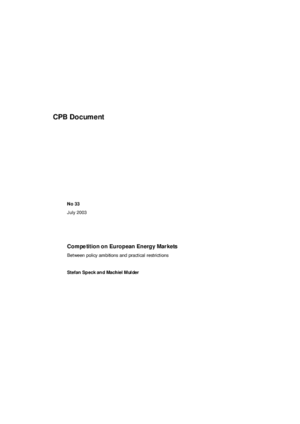Competition on European energy markets: between policy ambitions and practical restrictions
Liberalising electricity markets: lower prices if institutions are well-developed
A well-developed electricity market has sufficient suppliers of power, a spot market where suppliers and consumers can trade at a daily basis, sufficient cross-border connections of networks, and transparent national regulations of networks. If the electricity market is not well-developed, lower prices will fail to appear and liberalisation may even lead to higher electricity prices.
These are the main conclusions from CPB Document 33, Competition on European Energy Markets: between policy ambitions and practical restrictions. This Document describes the backgrounds and the rationale of the EU-liberalisation policy, explains why the policy goals have not yet been achieved, and discusses recent developments and some of the future challenges faced by policy makers. The Document focuses on the electricity market, but it also pays some attention to developments on the natural gas market.
Five years after launching the EU process of electricity liberalisation, the dominance of large utility companies, the lack of international transmission capacity, and national environmental policies hinder the creation of competitive energy markets and consequently lower electricity prices in Europe. Established utility companies still have a strong position on some national electricity markets. By means of (inter)national mergers, they increase their market shares at the European level resulting in a European market with little competition. Competition is also hampered by the lack of interconnection capacities between European countries. Moreover, the absence of coordinated management of allocation of the transmission capacity hinders power supply at foreign markets.
The Scandinavian countries and the United Kingdom have made large progress in liberalising the electricity market. At these markets, dominant firms do not exist, while well-shaped spot markets realise transparency of demand and supply. These measures have resulted in more competition between power producers and hence in lower prices.
In order to get liberalisation going, governments in other countries should counterbalance firms pursuing market power, increase interconnection capacities, encourage the development of transparent markets, and harmonise national rules regarding the access of networks.
Recent developments in these countries, however, raise worries about the security of supply. Profit maximising firms do not invest in capacity which will rarely be used. If end-user prices were allowed to reflect scarcity, and hence could surge when capacity is tight, investments in peak capacity would probably be profitable. Insufficient investment in super-peak generation capacity, which is seldom needed, can be seen as a market failure. This market failure arises from the fact that the private benefits of investing in super-peak capacity are smaller than the social benefits of preventing black-outs of the power network. One of the options to cope with this problem is the establishment of a so-called capacity market beside the commodity market.
The publication also describes the liberalisation process in the future EU member states. It appears that the speed in which markets are opened up strongly differs between these countries.
Read also the accompanying press release.
Five years after launching the process of electricity liberalisation, dominance of large utilities, lack of international transmission capacity, and national energy policies hinder the creation of competitive energy markets in Europe. Consequently, the expected downward convergence of electricity prices for EU business and EU consumers has only partly been realised.
Established utility companies still have a strong position on some national electricity markets. By means of (inter)national mergers, they increase their market shares at the European level. As a consequence, the price of electricity remains at a higher level than the costs of generating the electricity. In addition, producers lack strong incentives to decrease costs and to develop new techniques of generation owing to missing fierce competitive market forces.
The document shows that liberalising electricity markets increases competition provided that adequate institutional arrangements have been made. This requires, in general terms, combating dominant positions of producers by splitting up large established utility companies and implementing adequate surveillance on mergers, increasing capacities of interconnectors among the several member states, establishing spot markets at an international level, and encouraging encouraging transparency of national policies regarding production, transmission and trade.
